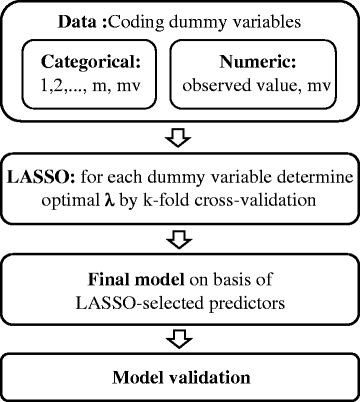Factors associated with performing tuberculosis screening of HIV-positive patients in Ghana: LASSO-based predictor selection in a large public health data set
- PMID: 27412114
- PMCID: PMC4944423
- DOI: 10.1186/s12889-016-3239-y
Factors associated with performing tuberculosis screening of HIV-positive patients in Ghana: LASSO-based predictor selection in a large public health data set
Abstract
Background: The purpose of this study is to propose the Least Absolute Shrinkage and Selection Operators procedure (LASSO) as an alternative to conventional variable selection models, as it allows for easy interpretation and handles multicollinearities. We developed a model on the basis of LASSO-selected parameters in order to link associated demographical, socio-economical, clinical and immunological factors to performing tuberculosis screening in HIV-positive patients in Ghana.
Methods: Applying the LASSO method and multivariate logistic regression analysis on a large public health data set, we selected relevant predictors related to tuberculosis screening.
Results: One Thousand Ninety Five patients infected with HIV were enrolled into this study with 691 (63.2 %) of them having tuberculosis screening documented in their patient folders. Predictors found to be significantly associated with performance of tuberculosis screening can be classified into factors related to the clinician's perception of the clinical state, as well as those related to PLHIV's awareness. These factors include newly diagnosed HIV infections (n = 354 (32.42 %), aOR 1.84), current CD4+ T cell count (aOR 0.92), non-availability of HIV type (n = 787 (72.07 %), aOR 0.56), chronic cough (n = 32 (2.93 %), aOR 5.07), intake of co-trimoxazole (n = 271 (24.82 %), aOR 2.31), vitamin supplementation (n = 220 (20.15 %), aOR 2.64) as well as the use of mosquito bed nets (n = 613 (56.14 %), aOR 1.53).
Conclusions: Accelerated TB screening among newly diagnosed HIV-patients indicates that application of the WHO screening form for intensifying tuberculosis case finding among HIV-positive individuals in resource-limited settings is increasingly adopted. However, screening for TB in PLHIV is still impacted by clinician's perception of patient's health state and PLHIV's health awareness. Education of staff, counselling of PLHIV and sufficient financing are needed for further improvement in implementation of TB screening for all PLHIV. The LASSO approach proved a convenient method for automatic variable selection in a large public health data set that requires efficient and fast algorithms.
Trials registration: ClinicalTrials.gov NCT01897909 (July 5, 2013).
Keywords: HIV/AIDS; LASSO; Sub-Saharan Africa; Tuberculosis screening; Variable selection.
Figures
Similar articles
-
Screening and testing for tuberculosis among the HIV-infected: outcomes from a large HIV programme in western Kenya.BMC Public Health. 2019 Jan 8;19(1):29. doi: 10.1186/s12889-018-6334-4. BMC Public Health. 2019. PMID: 30621655 Free PMC article.
-
Provider initiated tuberculosis case finding in outpatient departments of health care facilities in Ghana: yield by screening strategy and target group.BMC Infect Dis. 2017 Dec 1;17(1):739. doi: 10.1186/s12879-017-2843-5. BMC Infect Dis. 2017. PMID: 29191155 Free PMC article.
-
Implementation of systematic screening for tuberculosis disease and tuberculosis preventive treatment among people living with HIV attending antiretroviral treatment clinics in Ghana: a national pilot study.BMJ Open. 2024 May 28;14(5):e083557. doi: 10.1136/bmjopen-2023-083557. BMJ Open. 2024. PMID: 38806436 Free PMC article.
-
Chemoprophylaxis for tuberculosis in HIV-infected individuals in sub-Saharan Africa.East Afr Med J. 1998 Sep;75(9):520-7. East Afr Med J. 1998. PMID: 10493054 Review.
-
[Coinfection as a challenge of the health system. TB / HIV / AIDS - prevention and treatment in Ghana].Pharm Unserer Zeit. 2012 Jan;41(1):58-63. doi: 10.1002/pauz.201100453. Pharm Unserer Zeit. 2012. PMID: 22470919 Review. German. No abstract available.
Cited by
-
Factors contributing to the ceiling effect of the EQ-5D-5L: an analysis of patients with prostate cancer judged "no-problems".Qual Life Res. 2020 Mar;29(3):755-763. doi: 10.1007/s11136-019-02316-4. Epub 2019 Oct 3. Qual Life Res. 2020. PMID: 31583618 Free PMC article.
-
MRI-based radiomics machine learning model to differentiate non-clear cell renal cell carcinoma from benign renal tumors.Eur J Radiol Open. 2024 Oct 29;13:100608. doi: 10.1016/j.ejro.2024.100608. eCollection 2024 Dec. Eur J Radiol Open. 2024. PMID: 39525508 Free PMC article.
-
MR-based radiomics signature in differentiating ocular adnexal lymphoma from idiopathic orbital inflammation.Eur Radiol. 2018 Sep;28(9):3872-3881. doi: 10.1007/s00330-018-5381-7. Epub 2018 Apr 9. Eur Radiol. 2018. PMID: 29632999
-
Massive Parallelization of Massive Sample-size Survival Analysis.J Comput Graph Stat. 2024;33(1):289-302. doi: 10.1080/10618600.2023.2213279. Epub 2023 Jun 26. J Comput Graph Stat. 2024. PMID: 38716090 Free PMC article.
-
A Machine Learning Based Framework to Identify and Classify Non-alcoholic Fatty Liver Disease in a Large-Scale Population.Front Public Health. 2022 Apr 4;10:846118. doi: 10.3389/fpubh.2022.846118. eCollection 2022. Front Public Health. 2022. PMID: 35444985 Free PMC article.
References
-
- Acharjee A, Finkers R, Visser RG, Maliepaard C. Comparison of regularized regression methods for ~ omics data. Metabolomics. 2013;3:126.
-
- Derksen S, Keselman H. Backward, forward and stepwise automated subset selection algorithms: frequency of obtaining authentic and noise variables. Br J Math Stat Psychol. 1992;45(2):265–282. doi: 10.1111/j.2044-8317.1992.tb00992.x. - DOI
-
- Shimizu Y, Yoshimoto J, Toki S, Takamura M, Yoshimura S, Okamoto Y, Yamawaki S, Doya K. Toward probabilistic diagnosis and understanding of depression based on functional MRI Data Analysis with Logistic Group LASSO. PLoS One. 2015;10(5):e0123524. doi: 10.1371/journal.pone.0123524. - DOI - PMC - PubMed
-
- Tibshirani R. Regression Shrinkage and Selection via the Lasso. Journal of the Royal Statistic Society, Series B (Methodological) 1996;58(1):267–288.
MeSH terms
Substances
Associated data
LinkOut - more resources
Full Text Sources
Other Literature Sources
Medical
Research Materials


